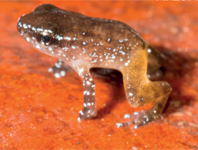Abstract
In 2017 the second author encountered a rather small Noctuidae species in western Sichuan (China) with unicolorous brown forewings and ochre reniform stigmata. Initially the six males collected resembled the taxa of the genus Cerapteryx Curtis, 1833, but the more gracile body, the finely serrate (and not bipectinated) male antennae and the late flight period indicated the need of further study. Dissection of the male genitalia revealed that the peculiar species belongs to the genus Blepharosis Boursin, 1964. The most recent review with descriptions of new Blepharosis taxa is available from Hreblay, Ronkay & Plante (1998). Comparison of external and genitalia features of the newly found taxon with the known species confirmed that it represents an undescribed species, which is very different externally from all but one of the members of Blepharosis. Regarding the configuration of the male genitalia, the only similar species is Blepharosis anachoretoides (Alphéraky, 1892), displaying only surprisingly small differences between the two species. The large difference between their barcodes (13.5% difference in the COI sequences) indicate however their specific distinctness despite their similar male genitalia structures.
References
Alphéraky, S. (1892) Lépidoptéres rapportés de la Chine et de la Mongolie par G.N. Potanine. Mémoires sur les Lépidoptéres, 6, 1–81.
Boursin, Ch. (1964) Noctuidae Trifiniae. Zweiter beitrag zur kenntnis der fauna der Noctuidae von Nepal. Veröffentlichungen der Zoologischen Staatssammlung München, 8, 3–40.
Caterino, M.S. & Sperling, F.A.H. (1999) Papilio phylogeny based on mitochondrial cytochrome oxidase I and II genes. Molecular Phylogenetics and Evolution, 11, 122–137.
https://doi.org/10.1006/mpev.1998.0549
Curtis, J. (1833) Characters of some undescribed genera and species indicated in the Guide to an Arrangement of British Insects. Entomological Magazine, 1, 186–199.
Hall, T.A. (1999) BioEdit: a user-friendly biological sequence alignment editor and analysis program for Windows 95/98/NT. Nucleic Acids Symposium Series, 41, 95–98.
Hreblay, M., Ronkay, L. & Plante, J. (1998) Contribution to the Noctuidae Fauna of Tibet and the adjacent regions (II). A systematic survey of the Tibetan Noctuidae fauna based of the material of the Schäfer-Expedition (1938-1939) and recent expeditions (1993–1997), Part I. List of species collected by the Schäfer-Expedition, Part II. List of species of the expeditions (1993–1997). Esperiana, 6, 69–184.
Kearse, M., Moir, R., Wilson, A., Stones-Havas, S., Cheung, M., Sturrock, S., Buxton, S., Cooper, A., Markowitz, S., Duran, C., Thierer, T., Ashton, B., Mentjies, P. & Drummond, A. (2012) Geneious Basic: an integrated and extendable desktop software platform for the organization and analysis of sequence data. Bioinformatics, 28 (12), 1647–1649.
https://doi.org/10.1093/bioinformatics/bts199
Kimura, M (1980) A simple method for estimating evolutionary rate of base substitutions through comparative studies of nucleotide sequences. Journal of Molecular Evolution, 16, 111–120.
https://doi.org/10.1007/BF01731581
Kumar, S., Stecher, G. & Tamura, K. (2016) MEGA7: Molecular Evolutionary Genetics Analysis version 7.0 for bigger datasets. Molecular Biology and Evolution, 33, 1870–1874.
https://doi.org/10.1093/molbev/msw054
Õunap, E., Viidalepp, J. & Saarma, U. (2005) Phylogenetic evaluation of the taxonomic status of Timandra griseata and T. comae (Lepidoptera: Geometridae: Sterrhinae). European Journal of Entomology, 102, 607–615.
https://doi.org/10.14411/eje.2005.085
Õunap, E., Viidalepp, J. & Saarma, U. (2008) Systematic position of Lythriini revised: transferred from Larentiinae to Sterrhinae (Lepidoptera, Geometridae). Zoologica Scripta, 37, 405–413.
https://doi.org/10.1111/j.1463-6409.2008.00327.x
Õunap, E., Viidalepp, J. & Truuverk, A. (2016) Phylogeny of the subfamily Larentiinae (Lepidoptera: Geometridae): integrating molecular data and traditional classifications. Systematic Entomology, 41 (4), 824–843.
https://doi.org/10.1111/syen.12195
Thompson, J.D., Higgins, D.G. & Gibson, T.J. (1994) ClustalW: improving the sensitivity of progressive multiple sequence alignment through sequence weighting, position specific gap penalties and weight matrix choice. Nucleic Acids Research, 22, 4673–4680.

